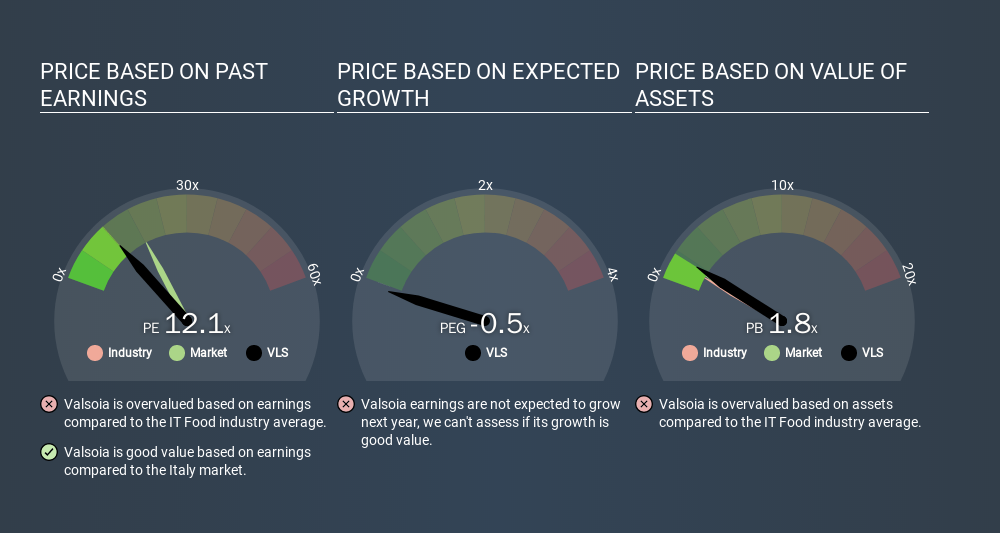
This article is for investors who would like to improve their understanding of price to earnings ratios (P/E ratios). We'll show how you can use Valsoia S.p.A.'s (BIT:VLS) P/E ratio to inform your assessment of the investment opportunity. Looking at earnings over the last twelve months, Valsoia has a P/E ratio of 12.15. In other words, at today's prices, investors are paying €12.15 for every €1 in prior year profit.
View our latest analysis for Valsoia
How Do You Calculate A P/E Ratio?
The formula for price to earnings is:
Price to Earnings Ratio = Price per Share ÷ Earnings per Share (EPS)
Or for Valsoia:
P/E of 12.15 = €11.00 ÷ €0.91 (Based on the year to June 2019.)
Is A High Price-to-Earnings Ratio Good?
A higher P/E ratio means that investors are paying a higher price for each €1 of company earnings. That is not a good or a bad thing per se, but a high P/E does imply buyers are optimistic about the future.
Does Valsoia Have A Relatively High Or Low P/E For Its Industry?
The P/E ratio essentially measures market expectations of a company. The image below shows that Valsoia has a P/E ratio that is roughly in line with the food industry average (12.1).

Valsoia's P/E tells us that market participants think its prospects are roughly in line with its industry.
How Growth Rates Impact P/E Ratios
If earnings fall then in the future the 'E' will be lower. Therefore, even if you pay a low multiple of earnings now, that multiple will become higher in the future. So while a stock may look cheap based on past earnings, it could be expensive based on future earnings.
Notably, Valsoia grew EPS by a whopping 36% in the last year. But earnings per share are down 3.9% per year over the last five years. If the company can grow EPS strongly, the market may improve its opinion of it. Further research into factors such as insider buying and selling, could help you form your own view on whether that is likely.
Don't Forget: The P/E Does Not Account For Debt or Bank Deposits
One drawback of using a P/E ratio is that it considers market capitalization, but not the balance sheet. That means it doesn't take debt or cash into account. In theory, a company can lower its future P/E ratio by using cash or debt to invest in growth.
Such spending might be good or bad, overall, but the key point here is that you need to look at debt to understand the P/E ratio in context.
Valsoia's Balance Sheet
With net cash of €21m, Valsoia has a very strong balance sheet, which may be important for its business. Having said that, at 18% of its market capitalization the cash hoard would contribute towards a higher P/E ratio.
The Bottom Line On Valsoia's P/E Ratio
Valsoia's P/E is 12.1 which is below average (18.2) in the IT market. It grew its EPS nicely over the last year, and the healthy balance sheet implies there is more potential for growth. One might conclude that the market is a bit pessimistic, given the low P/E ratio.
Investors have an opportunity when market expectations about a stock are wrong. If it is underestimating a company, investors can make money by buying and holding the shares until the market corrects itself. So this free visualization of the analyst consensus on future earnings could help you make the right decision about whether to buy, sell, or hold.
Of course you might be able to find a better stock than Valsoia. So you may wish to see this free collection of other companies that have grown earnings strongly.
If you spot an error that warrants correction, please contact the editor at editorial-team@simplywallst.com. This article by Simply Wall St is general in nature. It does not constitute a recommendation to buy or sell any stock, and does not take account of your objectives, or your financial situation. Simply Wall St has no position in the stocks mentioned.
We aim to bring you long-term focused research analysis driven by fundamental data. Note that our analysis may not factor in the latest price-sensitive company announcements or qualitative material. Thank you for reading.
About BIT:VLS
Valsoia
Provides valid dietary and nutritional solutions for health and wellbeing in Italy.
Flawless balance sheet average dividend payer.
Similar Companies
Market Insights
Community Narratives



